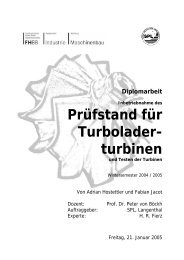Create successful ePaper yourself
Turn your PDF publications into a flip-book with our unique Google optimized e-Paper software.
other. It transmits vibrations it gives off heat, it loads the structure. The best known<br />
example of the consequences is the Russian moon rocket N-1. Their engines have been<br />
tested extensively on the ground and were considered flight qualified. The block A, the<br />
first stage with 30 engines, but has no one tested as a whole, because it was the cost of a<br />
test stand of the enormous thrust force of 46000 kN has wanted to save. This took<br />
revenge. All four launches of the N-1 failed because of problems with the block A.<br />
<strong>OTRAG</strong> The rocket is the same problem: only here it is up to 500 engines are ignited at<br />
once. Unlike other missiles, it is not possible to test the engines before the start: After a<br />
test run, the ablation layer melted away and the engine scrap. A single test run on the<br />
ground of a 500 engine beam is thus quite expensive. Probably could not afford <strong>OTRAG</strong><br />
also be capable of this test stand. (500 engines a takeoff thrust would result in up to 17<br />
500 kN, 15 times more than have a test stand for the Vulcain engine of Ariane 5 start to<br />
load).<br />
Engine failure<br />
Start No. 15 Image 3Ein Another point concerns the effects of engine failure. In the<br />
experiments until 1974, there were 3 failures in 200 trials. Later, it was only known that<br />
there should have been more than 2,000 tests, but no success rate. 3 failures in 200 trials<br />
is a standard in rocketry size that I want to talk to include in the considerations.<br />
At first it seems a Triebwerksaufall a rocket with so many engines is critical. If only the<br />
loss of thrust, this is also unrestricted. What one should not forget: Since each 2 engines<br />
are attached to a common tank, remains on premature shutdown still a lot of fuel that is<br />
not used and then changed the full / empty mass ratio.<br />
In other missiles with multiple engines, you can catch the engine failure by the other can<br />
burn longer. This happened, for example, the mission of Apollo 13 when one of the<br />
engines turned out the second stage. This possibility <strong>OTRAG</strong> the rocket did not.<br />
For the 4 ton version with 256 engines, I have times the probability and consequences of<br />
an engine failure for a confidence just 99%. (A loss in 100 firings) The amendment to the<br />
empty weight is for the "worst case" scenario, that the engine failure immediately after<br />
the ignition:<br />
Level number engine failure probability of a change in idle speed changing mass loss of<br />
payload<br />
1192 85.5% 4.7% -27 m / s -75 kg<br />
2 48 38.3% 18.8% -97 m / s -260 kg<br />
3 16 14.8% 56.3% -497 m / s -1350 kg<br />
Start No. 15 4Es image reveals the following: Although the failure of one engine in the<br />
first stage is relatively likely and should occur in virtually every mission, the impact is<br />
yet to begin. A cushion of 100 m / s, however, is today the exception rather rockets and a<br />
cushion of nearly 500 m / s corresponds to a reduction of the payload by a third.<br />
This means that the rocket <strong>OTRAG</strong> start with either a very large safety cushion needs, or















